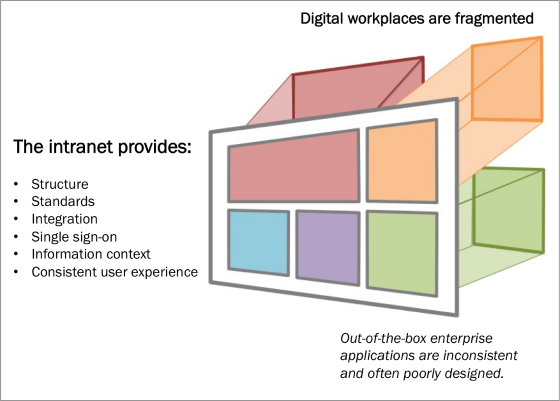Why is the intranet still important in the era of the digital workplace?
What is the role of the intranet in the modern digital workplace? Are intranets a relic of the past? What is the value of an intranet within the digital workplace?
In my first post I looked at our definition of the organization’s digital workplace being all the technology the organization provides to allow people to do their jobs. In the second post I looked at why the concept has been ignored and some of the activities we might undertake to improve matters. I also expressed the view that the intranet team had the sort of skills and experience to take on that sort of challenge. In this post I’d like to attempt to convince you that the intranet will remain an important concept in the era of the digital workplace.
Structure and answers
But why should it? After all it’s just an old nineties concept that keeps on being called dead every year. So let’s imagine a digital workplace without the intranet. IBF defines the intranet very broadly as any service provided to the employee via a web browser. If we were to do away with the intranet what would we mean? Presumably we’d still have all the individual assets – Yammer, the expenses application, lots of content – but just drifting and disconnected from each other. So that’s interesting isn’t it? The intranet is a tool of structure and coherence. A way of finding, searching, navigating and exploring – a way of communicating sense.
I am always struck when I speak to my IBF colleagues on the Usability benchmarking side about how frustrating intranets can be for users — they just want to get something done and get it done quickly or get an answer to a question. That’s a hard thing to do, and many intranets fail at it.
Do we think we can abandon the structure that the intranet provides and just revert to hard-coded links to enterprise applications from people’s PC desktops? That seems highly regressive. Or could we just let the users find answers to their questions by posting on a social network? No way. The social network may be an important bonus – with enormous social, economic and political impact – but when I’m looking for the date the performance management form needs to be submitted by, I’d prefer a cleaner answer.
The great mobile intranet experiences were are beginning to see are taking the needs of providing structure to users very seriously indeed. In fact, due to the constraints of mobile (smaller interfaces, slower connections, users on the go) we’re seeing a more focused and disciplined structure than on intranets.
The designed and the non-designed digital workplace
There is a fundamental division between the designed and the non-designed digital workplace. The designed digital workplace is the intranet and other tools we may have direct control over. It can express your brand, and your organization’s personality. The non-designed digital workplace is the other stuff – the commodity services such as Outlook, Office and Lync and a multitude of internal and cloud-based services. It remains resolutely out-of-the-box and you remain in a grey-commodity world.
Whenever there is a problem in the user experience of the designed digital workplace you can go in and fix it. Whenever there is a problem with the non-designed digital workplace you can’t go and fix it. You are stuck with what Microsoft or Salesforce or whoever has chosen for you, and you can sit there and fume while you wait for some form of upgrade.

Control over the intranet, but not over other enterprise apps
And this, for me, is why the intranet still is massively important in this post-firewall era. It is a place you can fix problems in the off-the-shelf systems that can’t be fixed directly. You want to curate a bunch of important Yammer groups and you can’t figure a way to do it in Yammer? Link straight to them from the intranet. No one can work out how to use the video conferencing? Provide user guides and how-to videos on the intranet.
The intranet remains one of the most useful digital workplace ideas and it has constantly evolved as a concept over the years. It’s not perfect, and the arguments about homepage real estate tend to rage as much as they ever did. But when you think about the intranet think gaffer-tape, crazy glue and Swiss Army knives.
One last thought: turn your intranet into a non-customizable commodity at your peril. If you move the intranet into the non-designed digital workplace you may lose the capability to react to these problems. Then the intranet really will be dead.
Related research: Digital workplace user experience
Digital workplace user experience – designing for a flexible workforce
 The digital ecosystem of applications and systems provided to employees have usually been built-up piecemeal for a desk-bound user population. The report suggests that organizations can tackle issues such as loss of productivity and reduced adoption of critical services by looking at the digital workplace through the lens of the user experience.
The digital ecosystem of applications and systems provided to employees have usually been built-up piecemeal for a desk-bound user population. The report suggests that organizations can tackle issues such as loss of productivity and reduced adoption of critical services by looking at the digital workplace through the lens of the user experience.
Categorised in: Collaboration, Digital workplace, Strategy & governance, Usability & design
